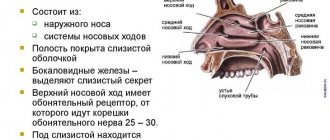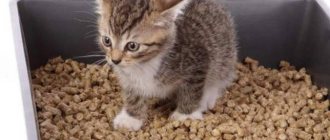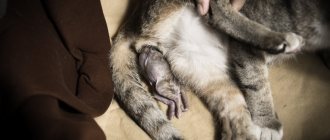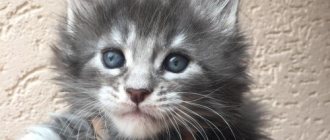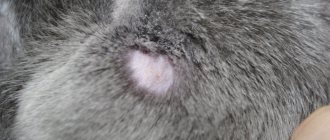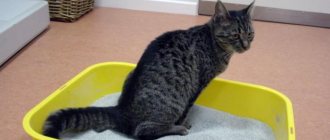An owner who cares for his pet should determine his well-being by the appearance of the animal. A cat's wet nose is considered a sign of health. The condition of the tip of a cat's nose is some indicator of the health or illness of the animal. A more accurate diagnosis, of course, can only be made by a veterinarian, whom you should contact if you suspect a disease.
The importance of the olfactory organ for a cat and its care
Indeed, the condition of a pet’s nose is an indicator of its health and you need to pay due attention to its condition, because the effectiveness of the cat’s interaction with the outside world depends on it. Thanks to the moisture of their nose, the cat family:
- Captures odors better (domestic cats' sense of smell is 15 times more acute than that of humans).
- Determines the temperature of food.
- Helps to hunt.
- Heat exchange occurs, in particular cooling of the body;
- Warms and purifies the air.
If nothing bothers your pet, then its nose should be clean, smooth to the touch, cool and slightly damp.
This is interesting: Reasons why a cat's nose swells
Condition of a healthy cat's nose
The nose of cats is a unique organ; its sense of smell is much stronger than that of humans. Animals constantly monitor its cleanliness so that their sense of smell, which is very important for them, does not decrease. Its front part is not covered with hairs and is called the lobe (or mirror). Due to the secretions of the mucous membrane, this organ is almost constantly wet and cool - this is its normal state.
If the lobe becomes dry and hot, this may be a sign of an elevated temperature in the cat and the onset of a disease. But this is not at all necessary; in healthy pets the mirror can also be hot. The color of the lobe may also change, for example, when it gets colder.
The respiratory humidity in cats can change several times a day. When they sleep and a few minutes after waking up, it is completely dry. Humidity also decreases after significant physical activity of the pet, especially if it is very active. The nose also becomes dry in a hot room or after the animal has suffered severe stress. In cats that like to be near heating appliances, this organ is hot and dry.
The mucus on your pet's nose helps him recognize any odors. And since cats do not have sweat glands, the mucus from the speculum helps maintain the normal condition of the entire body. With its mirror, the animal is able to determine the temperature of food without even touching it, using its organ as a thermometer.
general information
A cat's nose consists of two nasal canals separated by cartilage. The drawn air enters the nasal chambers, from which it enters the winding channels. In these channels, the smell is purified from foreign impurities, which allows the cat to recognize the nature of the smell.
cat nose
Special cells associated with the olfactory region of the brain are responsible for recognizing odors. The nasal sinuses perform not only the function of smell, but also thermoregulatory and filtering. The air drawn in has time to heat up to the required temperature and be cleaned of the smallest molecules of dust and bacteria.
The area accessible to human touch that is mistaken for the animal's nose is actually the skin around the nostrils and is called the lobe. It is by this that the owner judges the health status of the pet. A healthy cat's nose should be moist, cool and rough. But not noticeably wet and cold.
Why is my nose cool?
One of the main functions of the nasal lobe is the animal's thermoregulation. The lack of sweat glands in a cat's body means that cooling of the body in hot conditions occurs through the nasal cavity and open mouth, so the nose is cool.
Thermoregulation through the nose and open mouth
Deviation from the norm indicates possible pathological processes in the cat’s body, for example, a warm nose lobe indicates an increase in body temperature and a possible fight of the immune system against viruses or bacteria.
Why does a cat have a wet nose?
A moistened surface makes it easier for a cat to catch and recognize odors around; other animals, such as dogs, also have a similar feature.
Wet nose close up
How does a cat's nose work?
The nose of cats is a complex system, anatomically consisting of two passages separated by cartilage tissue. Inside, the cavity is “lined” with a mucous membrane, which is penetrated by many nerve endings and blood capillaries. The main role of the mucous membrane is to protect against household pollution, viruses and bacteria that can be transmitted from other animals and humans.
The mucous tissue also contains olfactory receptors, with the help of which, in fact, cats learn about the world around them. When you inhale, the air does not immediately enter the lungs, but is filtered by special pores and valves inside the nasal passages. Epithelial receptors “diagnose” odors received from the outside and give appropriate signals to the brain - there is danger ahead, hot food, the owner’s hands, an angry dog.
Also inside the nasal cavity there are special glands that secrete a mucous secretion, which protects the outer earlobe from drying out and cracking. Thanks to constant moisture, the animal can not only regulate its body temperature, but also significantly expand the range of its sense of smell.
Important: cats’ bodies are designed in such a way that they do not sweat naturally, and it is the nose that regulates heat exchange. It acts as a natural “cooler” in case of excessive activity or increased temperature outside in the summer.
Deviations to watch out for
Cat owners should be wary of:
- If the lobe is constantly very wet. You need to observe the behavior of the animal for 1-2 days.
- If mucous, purulent, bloody or serous discharge appears;
- If the animal refuses food, often sneezes, shakes its muzzle or rubs its paws, looks lethargic, has indigestion, pale mucous membranes or an increase in body temperature.
Why problems might arise
Causes of a constantly dry nose:
- infection;
- fever accompanying non-infectious and surgical diseases (for example, heart disease);
- dehydration of the body (the animal’s gums are also dry).
Hot ears and nose are a consequence of ear mites, stress, or prolonged exposure of the cat to the sun.
The most common causes of nasal discharge:
- allergies, accompanied by frequent sneezing and profuse lacrimation;
- hypothermia;
- lymphocytic rhinitis;
- idiopathic chronic rhinosinusitis;
- tumors;
- dental diseases;
- chronic sneezing;
- polyps on the nasal mucosa, while the animal’s breathing is difficult, he breathes through his mouth.
The most severe discharge is observed in allergic rhinitis or the early stages of a viral infection, because The glands responsible for secretion begin to work much more actively. The most irritating agents for the cat's nasal mucosa are cigarette smoke, vapors of acids and alkalis, ammonia, as well as plant pollen and preparations used to disinfect premises.
Other reasons for the discharge of clear, non-sticky secretion from the nose:
- poisoning;
- getting into the nose of insects (for example, fleas) or a powdery irritant, incl. chemical origin;
- a foreign object entering the nostril, if its sharp edges scratch the sinuses, there may be blood impurities;
- fungal diseases;
- congenital abnormal organ structure;
- helminthiasis
If the earlobe is moistened by secretions mixed with blood, the reason for this may be:
- injury to the nose or head;
- arterial hypertension, additional symptoms of the disease - staggering gait and irritability;
- destruction of nasal membranes caused by the spread of a brain tumor or chronic bacterial infections;
If there is mucus and pus discharge, the cat may suffer from viral infections:
- herpes;
- calcivirosis (discharge at the 1st stage of the disease is transparent, then becomes serous and purulent with a heavy odor, the animal’s body temperature increases to +40.5 ° C);
- secondary rhinitis.
In kittens, pus in the nasal and eye discharge is a sign of poor nutrition.
If even a small amount of blood or pus appears in the secretion, you should contact a veterinarian.
What should the owner do?
What should the owner do if he suspects his pet is unwell, but it is impossible to immediately take the mustachioed animal to the clinic? First of all, do not panic and observe the condition of your pet.
Of course, it is better to call the veterinarian and tell him about the situation. If the doctor does not see anything critical in the animal’s condition, several recommendations can be followed.
If you suspect your cat is not feeling well, you should measure its temperature. The norm for a mustachioed pet is 37-38 °C. And don’t panic; it’s better to observe the animal’s behavior throughout the day. Since the vital functions of the body are ensured by many systems, if one of them fails, the entire body suffers.
At the same time, if nasal dryness occurs due to physiological factors, treatment will not be needed. The main thing is that the pet always has access to water.
If the room is too dry and hot, you should ventilate it more often and do wet cleaning.
Diagnostics
If the temperature rises to 39.5 °C, go to the doctor immediately. In this case, you cannot treat alone, much less give the animal antipyretic drugs intended for humans. It is quite easy for a layman to make a mistake with the dosage, but exceeding the dose, on the contrary, will harm the pet.
Important! It is almost impossible to make a diagnosis on your own, since most of the symptoms are similar.
An animal, suffering from pain, may meow pitifully, but it is not able to say what is bothering it. Only an experienced veterinarian can guess what the cause of the disease is and carry out the necessary studies and tests. That is why it is necessary to consult a doctor to prescribe adequate treatment.
As you can see, there are many reasons why a cat’s nose dries out and becomes warm. And this is not always a sign of disease. If the pet feels great and its behavior does not cause suspicion, then you can simply wait a while and the nose will become wet and cool again. However, any accompanying sign of an abnormality in the animal’s behavior is a clear reason to visit the veterinary clinic.
Cats are mysterious and amazing creatures. Truly, they evoke tender feelings in almost any caring person. These creatures bring a lot of joy to those who cannot imagine life without a touching purring lump. And how much happiness a pet brings to its owner! If you do not take into account damaged furniture and minor pranks, then a cat in the house becomes an inexhaustible source of inspiration.
For many, she is the only companion and devoted friend. Many owners seriously think about why their cat has a wet nose? It seems that this is a long-known truth, however, it is completely incomprehensible to the majority of the population. Some people never think about such questions in their lives; they take reality for granted. Why do cats have wet and cold noses? Let's try to figure it out!
What should the owner do if he suspects his pet is unwell, but it is impossible to immediately take the mustachioed animal to the clinic? First of all, do not panic and observe the condition of your pet.
We invite you to familiarize yourself with Cat Scratching Post - 5 short buying tips
How to properly care for your cat's nose
To monitor your cat's health, you need to check the temperature of the nose with the back of your hand. This must be done carefully so as not to scare the pet.
It is necessary to be attentive, observe the behavior of the animal, monitor its appearance, provide adequate nutrition and good living conditions. Compliance with these requirements will help avoid the occurrence of diseases, as well as prevent serious consequences.
It is worth remembering that the health of the pet depends only on the owner. Only a healthy cat will be able to please and charge you with positive emotions.
What could be a reason for concern?
By changing the temperature of the humidity of the nose, you can trace some of the processes occurring in the pet’s body. Sometimes this can be one of the signs that your pet is sick. It is necessary to understand in general terms when to worry and when not to.
The main symptoms at which the disease begins to progress:
- Goes to the toilet often or rarely.
- Diarrhea or bloody discharge.
- The cat is constantly in a tense state of stress.
- Excessive hair loss.
- Vomit.
- Deep breathing.
The temperature of the nose can change throughout the day, so there is no need to panic if your pet has just woken up and has a dry nose, as everything will be back to normal in a couple of hours. There is a scientific explanation for this: during sleep the animal is at rest, its body temperature rises, partial dehydration of the body occurs due to insufficient water, and after waking up all biochemical processes are restored.
A cold nose can be a sign of a disease, but it is also accompanied by other symptoms, such as diarrhea, vomiting, fever, weakness, and lethargy. In this case, it is recommended not to undertake independent treatment from the Internet, but rather contact a veterinarian for qualified help.
A cold nose in itself should not be a cause for concern , as it may be a completely normal reaction. The disease can be determined by observing the accompanying symptoms with a low nose temperature, for example colds:
- You should feel your ears; they may be hot.
- The cat eats little, is less mobile, lethargic.
- Snorts or sneezes frequently.
- High body temperature.
Body temperature is measured not by the animal's nose, but by a thermometer. The usual one used by people is suitable for this.
This is interesting: Why does a cat hide his nose?
The cat has a cold and dry nose: what to do?
When a cat's nose is cold and dry, this is also a bad sign. This may happen for the following reasons:
- The cat has severe intoxication, regardless of its origin.
- During sepsis.
- If your pet is experiencing the thermal stage of some infectious disease.
- During intermittent fever. In this case, the animal’s temperature can periodically rise and then decrease.
- In each case, the nose becomes cold, as does the body of the animal. Most often, an unexpected drop in body temperature indicates that the animal’s brain does not have time to respond to thermoregulation.
Cold
- Sometimes this condition leads to the death of the pet. Immediately place the cat in a warm room (just make sure the room is not too hot), and call a veterinarian immediately. Self-treatment in such a situation can lead to big problems.
What to pay attention to
If the nose remains dry for a long time, this is usually a sign of the development of the disease, while a hot nose is a sign of increased body temperature. Not only the temperature and humidity of the olfactory organ can indicate health problems. A change in its color can also be a sign of a cat’s disease:
- lightening - typical in case of disturbances in the functioning of the circulatory system, hypothermia, poisoning;
- turning blue indicates a lack of oxygen or cardiovascular disease;
- yellowing - appears with kidney or liver diseases;
- redness - develops with damage, increased temperature or pressure, various types of infections (runny nose, sinusitis) and allergic reactions.
We invite you to familiarize yourself with the most dangerous cats in the world
In this matter, not everything is so simple, because the change in color is influenced by the surrounding temperature, as well as the color and breed of the pet: for some, the nose darkens in the cold, for others, on the contrary, it becomes slightly lighter. To determine your health status, the presence of other symptoms should also be taken into account. For example, if a cat refuses food and water, becomes lethargic and inactive, vomiting or upset stool appears - these are clear indications for consulting a veterinarian, who will be able to determine the causes of this phenomenon and provide the necessary assistance.
Constant moisture of the nose and its color as an indicator of health
Stable moisture indicates good health of the pet. Based on the color of the organ, the condition of the patient is judged as follows:
- A smooth, cool, moist pink nose on a healthy cat.
- White indicates problems with the circulatory system.
- A red tint with pronounced signs of inflammation and excess mucus indicates rhinitis.
- Blueness of a wet or dry organ is the first sign of heart disease or lack of oxygen.
- Strong yellowness in humidity indicates problems with the liver and kidneys.
Pet care rules
A healthy individual copes with personal hygiene quite independently. If for some reason the ambient temperature rises, the cat actively licks itself and intensively moisturizes its nose. Similar actions are observed when any type of contamination comes into contact with the lobe , for example, litter, pollen. In the natural environment, animals usually free their noses from interfering masses mechanically. For these purposes, the entrance is through normal contact with grass, trees, and all kinds of plants. As for domesticated pets, they solve the problem described by intensive washing.
The exception is representatives of flat-faced breeds. They differ in that, through a complex selection process, they acquire altered anatomical proportions of the head. Due to the fact that the nasal septum is damaged, very often excess mucus and dried crusts form in the nostril area, which need to be regularly eliminated. In such situations, formations in the form of snot and scales are removed using cotton swabs and sanitary swabs. Activities that are recommended to be avoided:
- Treatment of the nasal sinuses with currently frequently used wet wipes impregnated with alcohol compounds, perfumed fragrances or antibacterial impregnations. The mucous membrane often reacts to such ingredients with allergic reactions, followed by a deterioration in the general condition.
- Using brilliant green or regular iodine as disinfectants, especially if there are scratches, cracks, or abrasions. Treatment with such compounds can lead to severe swelling and burn lesions that do not heal for a long time. As a result, breathing becomes significantly more difficult, the pet suffers serious stress and discomfort, and exhibits excessive nervousness.
In any case, qualified veterinarians do not recommend self-medicating your four-legged friend. If there are first signs of discomfort associated with difficulty breathing due to nasal congestion, you need to seek help from a veterinary clinic to determine an accurate diagnosis and carry out appropriate therapy.
Care Tips
Do not wipe the earlobe with different wet wipes, as they can cause allergies. If any dirt gets inside, the mucous membrane is able to remove it itself. The animal may need help cleaning visible parts of itself. If there are persistent stains or dry crusts from snot on the surface, they can be carefully removed with a cotton swab. If the crusts are very dry, they can be pre-lubricated with Vaseline oil. Such problems often appear in breeds with a flat face; they cannot take good care of themselves.
If your cat's nose is very wet, you can lightly blot it with a paper towel. If you find scratches or wounds on it, do not treat them with iodine or brilliant green. These drugs can cause severe burns to the animal's respiratory tract, which can lead to serious complications. Basically, the cat keeps its mirror clean on its own. If it is very hot, the pet will lick it. If dust or debris gets into it, it will sneeze to cleanse the nasal passages and wash itself.
Any person who has ever interacted with cats knows that you can determine the state of health by touching the animal’s nose. But this sign may not be reliable enough. Only a few negative symptoms after observing the pet can indicate a more accurate diagnosis.
Causes of anxiety
An important initial symptom, indicating the development of any pathological processes in the pet’s body, is a dry and very hot nose. At the same time, owners of mustachioed animals should not forget that their normal body temperature varies from +38 to +39°C. A cat or cat, being completely healthy, may have a hot and dry earlobe. The main signs indicating an animal’s illness are presented in the following list:
- An overly moisturized olfactory organ with a high body temperature, while there is no apatite, makes itself felt by regular sneezing. In such a situation, we can talk about the development of ARVI, a respiratory disease.
- Liquid is released from the nostrils in a large volume, and the pet’s ears burn badly. Such symptoms may indicate the development of a serious infection in the form of panleukopenia or rhinotracheitis.
- Copious nasal discharge, which contains purulent impurities and bloody clots. This indicator can manifest itself when foreign objects of various origins enter the nasal sinuses.
- Excessive sputum from the olfactory organ, resulting from an allergic reaction to seasonal plant pollen, household caustic chemicals, medications used for a long time, tobacco smoke, street or house dust.
- A very cold and moistened nose is direct evidence of the cat's hypothermia and poisoning.
- If your four-legged “friend” breathes heavily and mainly through the nose, sniffles, while the lobe remains wet all the time, you should think about the appearance of a polyp, massive damage to the mucous membranes.
An important sign that should not be overlooked is the color of the outer part of the nose. The shade of the wet “snuff” determines the general condition of the pet:
- yellow color of the olfactory organ - the presence of problems with the liver or kidneys;
- a cool, smooth pink nose indicates good general condition;
- cyanosis indicates a lack of oxygen, malfunctions of the cardiovascular system;
- white nose - a disturbance in the functioning of the circulatory system;
- A clear sign of rhinitis is inflamed and reddish nostrils.
Causes of humidity
Humidity is explained by the presence of special glands that secrete mucus. The secret helps protect the skin from drying out. Mucus transports particles of volatile substances to the receptors, sharpening the animal's sense of smell.
Surface wetting is inherent in the cat family at the genetic level due to the fact that these animals are predators.
The wet organ helps determine the direction of the wind, and this is required for the correct choice of the side to attack the victim.
In hot weather, moisture evaporates from the surface - this is how thermoregulation occurs. Quadrupeds do not have sweat glands, and the nose is the only means of cooling.
Physiological features
The internal structure of a cat's olfactory organ is similar to a human's. The nasal cavity consists of two passages with a cartilaginous septum in the middle.
The mucous membrane of the nostrils is formed from blood vessels and nerve endings. The epithelium has glands that secrete mucus and a number of sensitive receptors. The nose protects the body from the penetration of pathogenic viruses and bacteria, allows you to recognize aromas and determine their nature.
The power of a cat's sense of smell is 15 times higher than that of a human. This is explained by the fact that when inhaled, oxygen does not quickly enter the lungs, but is retained in the turbinates and pores of the nasal system. Irritated receptors transmit information to the brain, and the animal identifies the object.
The color and shape of a cat’s nose depend on its anatomy, breed, and age. More often the color of the lobe is identical to the color of the fur on the muzzle. Older quadrupeds have a darker nose than kittens.
The volume of discharge is determined by the shape of the nose and depends on the structure of the skull bones and cartilage.
Pets with flattened faces often have breathing problems, so their owners have to be more attentive to the state of the animal's sense of smell.
Possible accompanying symptoms when feeling unwell
Be that as it may, a dry and at the same time warm nose can be a sign of a disease that is important not to miss. Therefore, you should not postpone a trip to the veterinarian if other signs are still present:
- dryness is accompanied by the fact that the pet’s ears become hot;
- the animal lost its appetite, lethargy and apathy appeared. In this case, the pet does not react to familiar stimuli, and the temperature has risen to 38.5 °C;
- purulent or mucous discharge from the nose. Typically, such symptoms are accompanied by viral diseases;
- In addition to dryness, the cat exhibits distress and vomiting. Thus, the spout indicates dehydration of the body;
- eyes water, throat dries. A virus may develop or an allergy may occur. Although it may simply be a matter of dry air;
- the cat stopped drinking, her fur became dull and unkempt. This indicates a malfunction of the mucous membranes and dehydration of the body;
- the pet does not make contact, does not eat and sleeps little. This behavior indicates stress;
- increased hyperactivity, the mustachioed pet has become irritable and eats a lot. These signs may indicate neurosis. If the temperature rises to 39.5 °C, you should immediately contact a veterinarian.
Did you know? Nature has arranged it in such a way that cats with congenital anomalies of the nose or respiratory system die. And the reasons for this are not infections or a virus at all, but ordinary hunger. An animal deprived of its sense of smell is simply unable to track and catch prey.
When to contact a veterinarian?
There are symptoms that require you to consult a veterinarian:
- Lethargy, passivity, malaise.
- Increased temperature of the nose, dryness.
- The color of the nose is pale and cold.
- The nose changed color to blue, red, yellow or white.
If one of the above symptoms is detected, there is no need to self-medicate ; you must contact a specialist, notifying him in detail about the cat’s symptoms. The veterinarian will collect the necessary tests, the results of which will help him determine the diagnosis and determine the course of treatment.
Nutrition
A cold nose in combination with other symptoms is an indicator that may indicate a weakened immune system . Owners who don’t bother about their cat’s diet prefer to limit themselves to buying dry food. Dry food causes dehydration of the body, followed by failure of internal organs. It is recommended to dose the daily amount of dry food with regular homemade food. Cats are predators, so the body requires natural food - meat.
Proper nutrition helps a cat build normal organ functioning, increase resistance to diseases, withstand negative environmental influences and always be in good shape.
What are the causes of a dry and cracked nose?
The main cause of dry and cracked nose is the environment. You may also notice that your pet's nose changes color. Spending time in the sun can change the texture and moisture of a cat's nose. The hotter the weather, the drier the animal's nose becomes. Relaxing in a hot home environment in winter can cause the same problem, especially if there are hot radiators that dry out the indoor air. As the climate changes from hot to cold, the cat's nose will likely begin to change as well.
Symptoms of the disease
A very wet nose in a cat is most often a symptom of colds or acute respiratory diseases. Symptoms that usually accompany a cold are increased body temperature, decreased appetite or complete refusal to eat, and low physical activity. At the same time, the coat loses its well-groomed shine, redness of the mucous membranes and tearing are possible.
Why does a cat lick a person: the main reasons and what it means
A pet with a cold becomes capricious, like a child, and less often aggressive. He sneezes, coughs and rubs his nose with his paws, constantly trying to warm up by the radiator, under a blanket or in the arms of his owner. Colds are rare among cats, as their bodies easily cope with such pathogens.
The following can undermine a cat’s immune defense:
- high humidity and drafts in the room;
- constant deficiency of beneficial microelements due to an unbalanced diet;
- hypothermia due to walking in rainy weather;
- Wool that is not completely dry after washing.
A pet with a cold needs to be given rest and plenty of fluids. For example, warm milk, low-fat broth and water work well. It is recommended to alleviate the symptoms: blot your eyes with a cotton pad soaked in boiled water and remove nasal discharge.
Important! If the cat does not cope with the disease within 24 hours, it is necessary to seek advice from a veterinary clinic, where treatment will be prescribed (in especially advanced cases, antibiotics).
A very cold nose in a cat may be a sign of an illness occurring in the body, but there must also be some other symptoms, for example, vomiting, diarrhea, a lethargic and apathetic state, decreased or lack of appetite.
Signs that your cat is sick:
- A raw nose due to heavy discharge and hot ears are symptoms of an ongoing infection (rhinotracheitis, panleukopenia, etc.)
- Copious nasal discharge with traces of blood or pus is most often the result of a foreign body entering the nasal canal.
- Excessive nasal discharge and tearing are symptoms of a cat’s allergic reaction to recently introduced foods, household chemicals, medications, pollen, dust, tobacco smoke, etc.
- A cat's wet and cold nose, accompanied by a drop in body temperature, may be a sign of hypothermia or toxic poisoning.
Colds in cats
- A cat's wet nose, wheezing when inhaling air, or breathing through the mouth indicate the presence of polyp growths or damage to the mucous membrane inside the organ.
- A cold and pale nose can be a symptom of anemia or other blood problems, a bluish tint to the skin of the nose indicates cardiovascular insufficiency, and a yellowish color indicates liver or kidney problems.
- A cold, dry nose with possible hair loss and decreased physical activity is a consequence of weakened immunity, which is caused by an unbalanced diet. Eating only dry food over time causes dehydration and malfunction of internal organs. Cats are hunters by nature and require meat in their diet.
Cat nasal discharge
Note! If you notice that your cat is leaking suspicious fluid from his nose, is having difficulty breathing, is sniffling or wheezing, consult a veterinarian who will make a diagnosis and prescribe the correct treatment.
Excessive humidity
Allocations must be standardized. Any decrease or increase in them should alert the owners . Snorting and difficult breathing against a background of humidity may indicate the presence of polyps or damage to the inner surface of the nasal passages.
An excessively cold and wet organ is a sign of hypothermia or poisoning. A cold is suspected when there is a rise in temperature, sneezing, or excessive discharge.
High humidity is normal for Persians and other breeds with flattened faces.
When to worry
One of the first symptoms indicating some kind of illness or illness in your pet is a dry and hot nose. However, do not forget that the body temperature of cats differs from the human norm and ideally equals 38-39 °C. The animal may be completely healthy, but the lobe will feel hot.
Signs indicating that the cat is still sick may include the following:
- Copious discharge flows from the nose, ears burn. Symptoms indicate the presence of an infection, such as rhinotracheitis or panleukopenia.
- Too wet nose, elevated body temperature, sneezing, lack of appetite. Perhaps there is a cold or acute respiratory viral infection.
- Copious discharge from the nasal cavity, containing blood or purulent inclusions. The possibility of some foreign object getting into the nasal passage cannot be ruled out.
- Excessive mucus discharge from the nose may be an allergic reaction to household chemicals, pollen, tobacco smoke, medications, or house or street dust.
- The lobe is very wet, and the cat itself sniffles heavily and breathes mainly through its mouth. Such symptoms may indicate the presence of a polyp and damage to the mucous membrane inside the nasal cavity.
- A wet and very cold nose indicates hypothermia or poisoning.
You can also judge the presence of health problems by the color of your nose. Thus, a bluish tint, as a rule, is a consequence of disorders in the cardiovascular system. Yellow almost always gives a “hint” to problems with the kidneys or liver. White indicates changes in the functioning of the circulatory system.
When your nose is dry
A cat is an active creature that spends a lot of energy on somersaults, jumps, and deceptive maneuvers that require high energy costs. A healthy cat, with the habits of a night hunter and lover of walking, is obliged to compensate for hard work with a long rest. This is achieved by sleeping for many hours.
To be constantly alert, all organs and parts of the body must rest. Therefore, the nasal glands stop their secretory activity during rest. The result of this is a dry, warm nose. It seems hot to the owner because the intensity of metabolism, and ultimately the cat’s body temperature, is higher.
A similar phenomenon is observed after activity during hunting or play.
The wet state usually returns after half an hour, when the glands secrete a sufficient amount of mucus, or the cat fixes the problem with its own wet tongue. If after some time the nose remains hot and dry, it becomes necessary to conduct thermometry.
If your pet is active, cheerful, and playful, there is nothing to worry about. But when dryness is combined with lethargy and lack of appetite, it is necessary to find out the reason for what is happening.
Clean the nose with a cotton swab
Wet olfactory organ as a sign of pathology
When illness occurs, your pet's nose may become dry, hot, or excessively wet.
An increase in humidity, the presence of mucus, crusts, peeling, and blood means the presence of the following problems:
- Penetration of a bacterial or fungal infection into the body.
- Entry of foreign objects into the respiratory tract.
- Allergic reaction.
- Injuries.
- Tumors.
- Diseases of the oral cavity.
You should consult a doctor if your animal exhibits the following symptoms along with the problems that have arisen:
- high body temperature;
- lethargy and passivity;
- hot ears.
- vomit;
- crusts under the nose;
- peeling of the skin;
- blood, pus;
- difficulty breathing, wheezing;
- refusal to eat;
- change in nose color.
Why does the kitten have a hot nose?
Kittens are very playful and active, they run, jump and play a lot. Because of this, it often happens that a kitten has a hot nose, and this is not at all a cause for concern. If you notice that his nose remains dry throughout the day, it’s time to start sounding the alarm. As a rule, in this case, on the second day, discharge appears from the nose - colorless or purulent. This is a sign of rhinitis - viral, allergic, bacterial or fungal. Sometimes the reason is a foreign body entering the nasal cavity or neoplasms in the sinuses and passages.
Sensitive sense of smell
There is a very widespread opinion among experts in the field of felinology that if a cat could speak and had a human mind, it would certainly become a professional perfumer. This animal has a rather sensitive sense of smell, which is only slightly inferior to that of a dog. Why does my cat have a very wet nose? Otherwise, the animal simply would not have the opportunity to perceive the surrounding reality at the proper level.
If the cat did not have such an amazing sense of smell, it would not be able to hunt small rodents and birds. And although at home there is absolutely no need to maintain its natural talents, the animal still remains a predator with sharp claws and has quite strong jaws.
Treatment
Even an experienced breeder will not be able to diagnose a dangerous disease just because the cat’s nose has become hot and dry. It is easy to make a mistake in diagnosis even based on a combination of external signs.
The main thing that the owner of a sick animal should do before contacting a veterinarian is to measure the temperature of his pet. At home, its indicator will be more accurate than in the clinic, where the cat usually experiences additional stress, aggravating the patient’s condition.
What you can handle on your own
If nothing serious has happened, the owner can bring things back to normal himself - there are a lot of similar situations, we will describe only the most common ones.


